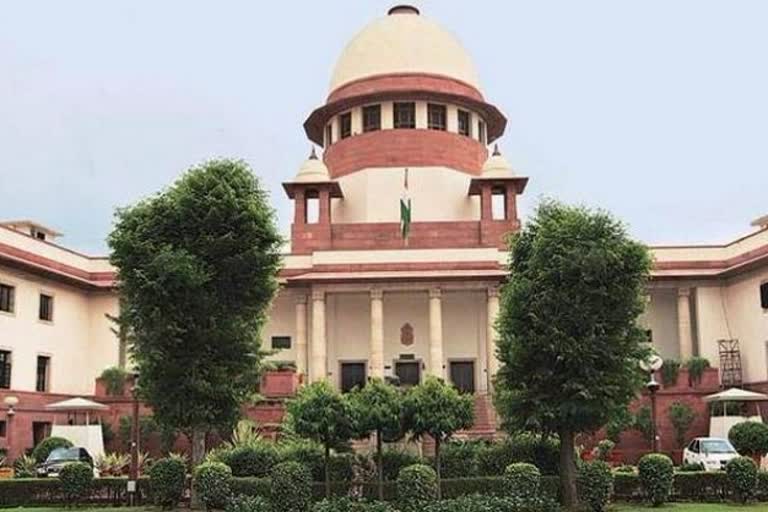नई दिल्ली : उच्चतम न्यायालय ने राम जन्मभूमि-बाबरी मस्जिद भूमि विवाद में एक और हिन्दू वादी को अपना लिखित नोट दाखिल करने की गुरुवार को इजाजत दी. इस वादी ने न्यायालय से अनुरोध किया है कि यदि शीर्ष अदालत यह व्यवस्था देती है कि हिन्दू और मुस्लिम पक्ष में से किसी का भी 2.77 एकड़ विवादित भूमि पर मालिकाना हक साबित नहीं पाया तो इसे सरकारी जमीन घोषित किया जाये.
उमेश चन्द्र पाण्डे ने, जिन्हें 1961 में दायर वाद में उप्र सुन्नी केन्द्रीय वक्फ बोर्ड ने प्रतिवादी बनाया था, प्रधान न्यायाधीश रंजन गोगोई की अध्यक्षता वाली पीठ के समक्ष अयोध्या मामले का उल्लेख किया और राहत में बदलाव के बारे में लिखित नोट दाखिल करने की अनुमति चाही.
प्रधान न्यायाधीश रंजन गोगोई की अध्यक्षता वाली पांच सदस्यीय संविधान पीठ ने अयोध्या में राम जन्मभूमि-बाबरी मस्जिद भूमि विवाद में इलाहाबाद उच्च न्यायालय के सितम्बर, 2010 के फैसले के खिलाफ दायर अपीलों पर 16 अक्टूबर को सुनवाई पूरी की थी.
संविधान पीठ ने सभी पक्षों से कहा था कि सुनवाई के दौरान उठे मुद्दों के परिप्रेक्ष्य में वे राहत में बदलाव के बारे में 19 अक्टूबर तक लिखित नोट दाखिल करें ताकि न्यायालय निर्णय के योग्य मुद्दों को सीमित कर सके.
ये भी पढ़ें : अयोध्या विवाद मामले में सुनवाई पूरी, फैसला सुरक्षित
पाण्डे की ओर से वरिष्ठ अधिवक्ता वी. शेखर ने जब गुरुवार को लिखित नोट दाखिल करने की अनुमति मांगी तो प्रधान न्यायाधीश ने टिप्पणी की, 'हम समझ रहे थे कि अयोध्या प्रकरण पूरा हो गया.'
हालांकि, पीठ ने उन्हें यह नोट दाखिल करने की अनुमति दे दी.
पाण्डे ने अपने नोट में कहा है कि लार्ड डलहौजी ने 1856 में अवध के नवाज को अपदस्थ करने के बाद अवध की पूरी रियासत को अपने अधीन कर दिया था. बाद में लार्ड कैनिंग ने तीन मार्च, 1858 में एक आदेश जारी करके अवध की सारी भूमि के मालिकाना हक ब्रिटिश सरकार के पक्ष में जब्त कर लिया था.
नोट में कहा गया है कि इसलिए अयोध्या की विवादित भूमि नजूल (सरकार) की जमीन हो गयी और आज भी वही स्थिति बरकरार है, जिसे मुस्लिम पक्षकारों ने भी स्वीकार किया है.
ये भी पढ़ें : अयोध्या मामला: मुस्लिम पक्षकार वक्फ बोर्ड के दावे से हैरान, कहा- समझौते का प्रस्ताव स्वीकार नहीं
शीर्ष अदालत ने इससे पहले मंगलवार को 'निर्वाणी अखाड़ा' को लिखित नोट दाखिल करने की अनुमति दी थी. इस नोट में निर्वाणी अखाड़ा ने उस स्थल पर श्रद्धालु के रूप में रामलला की पूजा अर्चना के प्रबंधन का अधिकार देने का अनुरोध किया था.
इस मामले में निर्मोही अखाड़ा और निर्वाणी अखाड़ा दोनों ही रामलला विराजमान के जन्मस्थल पर पूजा और प्रबंधन के अधिकार चाहते हैं.



